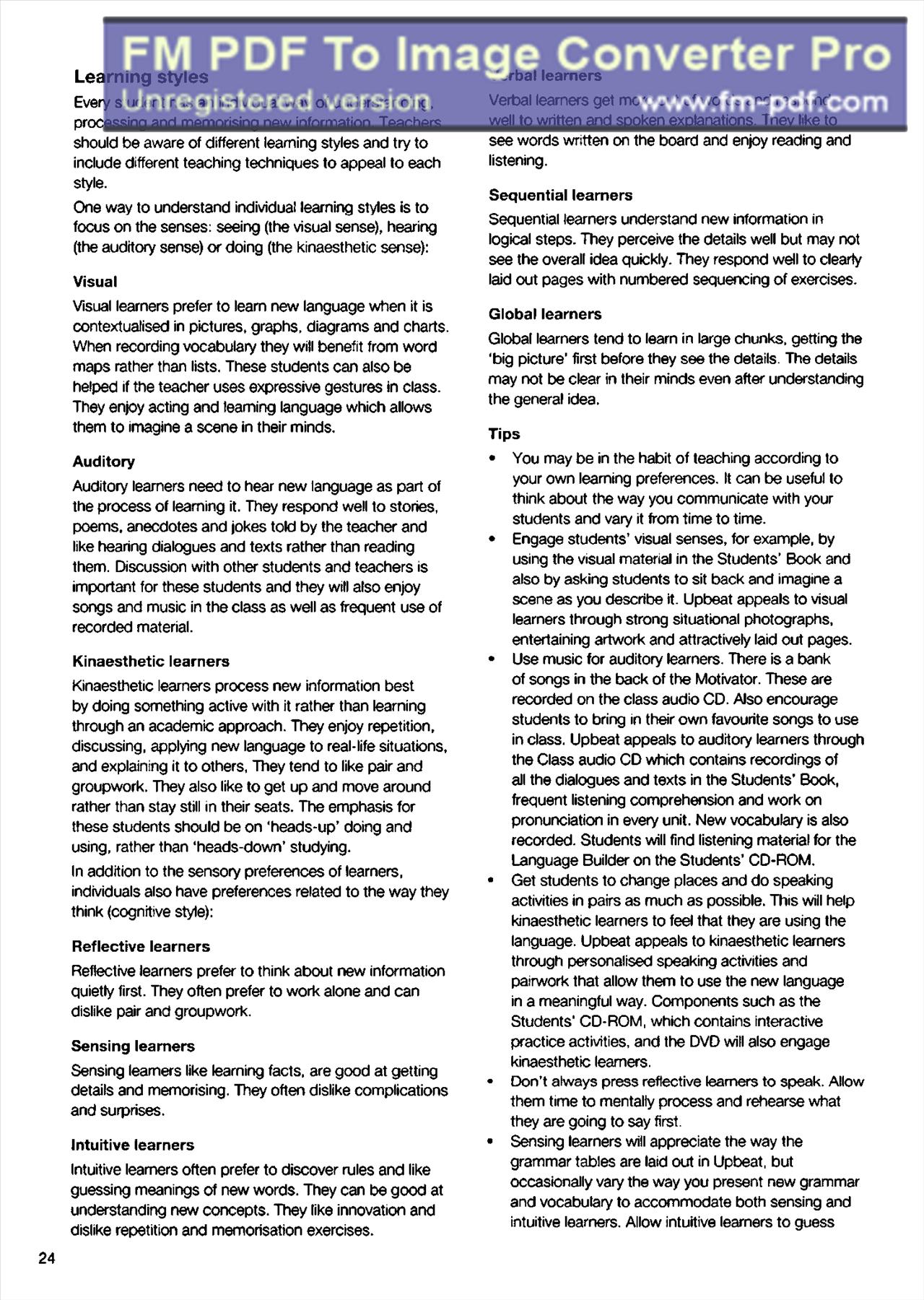Up¾at 3 Teacher's Book podrecznik nauczyciela plus odpowiedzi ,testy,klucz answer key Page 023


see words wntten on the board and enjoy reading and listening.
should be aware of different leaming styles and try to include different teaching techniques to appeal to each style.
One way to understand individual learning styles is to focus on the senses: seeing (the visual sense), hearing (the auditory sense) or doing (the kinaesthetic sense):
Visual
Visual learners prefer to leam new language when it is contextualised in pictures. graphs. diagrams and charts. When recording vocabulary they will benefit from word maps rather than lists. These students can also be heiped if the teacher uses expressive gestures in class. They enjoy acting and leaming language which allows them to imagine a scene in their minds.
Auditory
Auditory leamers need to hear new language as part of the process of leaming it. They respond well to stońes, poems, anecdotes and jokes told by the teacher and like hearing dialogues and texts rather than reading them. Discussion with other students and teachers is important for these students and they will also enjoy songs and musie in the class as well as frequent use of recorded materiał.
Kinaesthetic learners
Kinaesthetic learners process new information best by doing something active with it rather than learning through an academic approach. They enjoy repetition, discussing, applying new language to real-life situations, and explaining it to others, They tend to like pair and groupwork. They also like to get up and move around rather than stay still in their seats. The emphasis for these students should be on 'heads-up’ doing and using, rather than ‘heads-down’ studying.
In addition to the sensory preferences of learners, individuals also have preferences related to the way they think (cognitive style):
Reflective learners
Reflective learners prefer to think about new information quiet!y first. They often prefer to work alone and can dislike pair and groupwork.
Sensing leamers
Sensing leamers like learning facts, are good at getting details and memorising. They often dislike complications and surprises.
Intuitive learners
lntuitive leamers often prefer to discover rules and like guessing meanings of new words. They can be good at understanding new concepts. They like innovation and dislike repetition and memorisation exercises.
Sequential leamers
Sequential learners understand new Information in logical steps. They perceive the details well but may not see the overall idea quickly. They respond well to dearfy laid out pages with numbered seguencing of exerdses.
Global learners
Global learners tend to learn in large chunks. getting the
‘big picture' first before they see the details The details
may not be elear in their minds even after understanding
the generał idea.
Tips
• You may be in the habit of teaching according to your own leaming preferences. It can be useful to think about the way you communicate with your students and vary it from time to time.
• Engage students’ visual senses, for examp)e, by using the visual materia! in the Students' Book and also by asking students to sit back and imagine a scene as you describe it. Upbeat appeals to visual learners through strong situational photographs, entertaining artwork and attractively laid out pages.
• Use musie for auditory learners. There is a bank of songs in the back of the Motivator. These are recorded on the class audio CD. Also encourage students to bring in their own favourite songs to use in class. Upbeat appeals to auditory learners through the Class audio CD which contains recordings of
all the dialogues and texts in the Students’ Book, frequent listening comprehension and work on pronunciation in every unit. New vocabulary is also recorded. Students will find listening materiał for the Language Builder on the Students’ CD-ROM.
• Get students to change places and do speaking activities in pairs as much as possible. This will help kinaesthetic learners to feel that they are using the language. Upbeat appeals to kinaesthetic learners through personaiised speaking activities and pairwork that allow them to use the new language in a meaningful way. Components such as the Students' CD-ROM, which contains interactive practice activities, and the DVD will also engage kinaesthetic leamers.
• Don’t always press reftective leamers to speak. Allow them time to mentally process and rehearse what they are going to say first.
• Sensing learners will appreciate the way the grammar tables are laid out in Upbeat, but occasionally vary the way you present new grammar and vocabulary to accommodate both sensing and intuitive learners. Allow intuitive learners to guess
24
Wyszukiwarka
Podobne podstrony:
Up?at 3 Teacher s Book podrecznik nauczyciela plus odpowiedzi ,testy,klucz answer key Page 196 b J *
Up?at 3 Teacher s Book podrecznik nauczyciela plus odpowiedzi ,testy,klucz answer key Page 027 Get s
Up?at 3 Teacher s Book podrecznik nauczyciela plus odpowiedzi ,testy,klucz answer key Page 098 8 New
Up?at 3 Teacher s Book podrecznik nauczyciela plus odpowiedzi ,testy,klucz answer key Page 189 â– i if
Up?at 3 Teacher s Book podrecznik nauczyciela plus odpowiedzi ,testy,klucz answer key Page 001 FM PD
Up?at 3 Teacher s Book podrecznik nauczyciela plus odpowiedzi ,testy,klucz answer key Page 005 Conte
Up?at 3 Teacher s Book podrecznik nauczyciela plus odpowiedzi ,testy,klucz answer key Page 006 Conte
Up?at 3 Teacher s Book podrecznik nauczyciela plus odpowiedzi ,testy,klucz answer key Page 009 FM PD
Up?at 3 Teacher s Book podrecznik nauczyciela plus odpowiedzi ,testy,klucz answer key Page 010 : Rea
Up?at 3 Teacher s Book podrecznik nauczyciela plus odpowiedzi ,testy,klucz answer key Page 012 Large
Up?at 3 Teacher s Book podrecznik nauczyciela plus odpowiedzi ,testy,klucz answer key Page 013 u mfo
więcej podobnych podstron